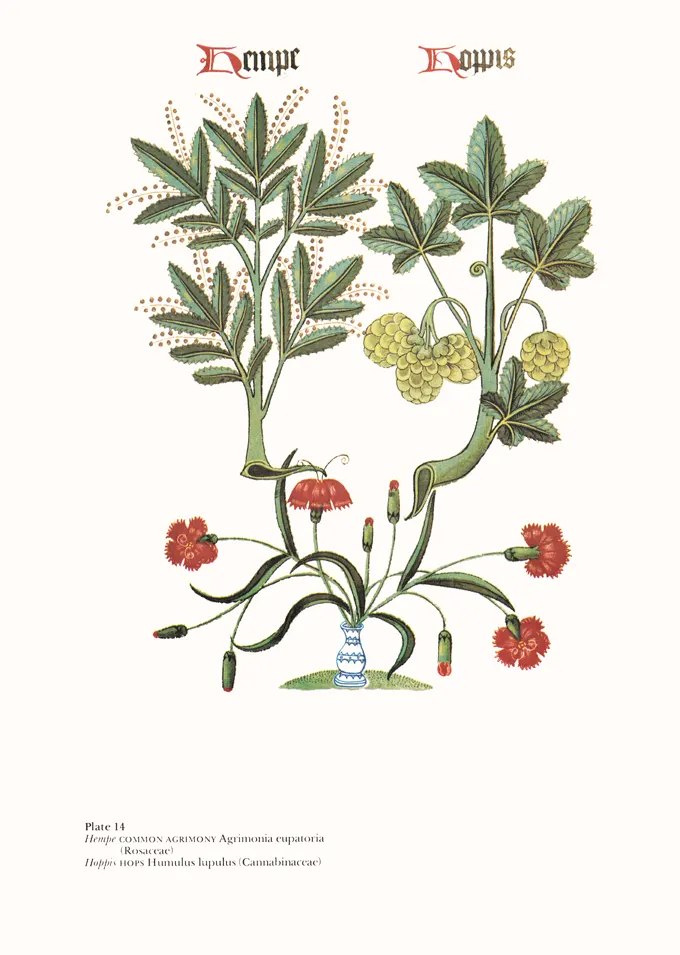Hemp & Hops
£15.00
Hemp and Hops (scroll down for a more detailed Description)
Published 1972 by © Hugh Evelyn Limited; drawn around 1525, these images were finished in gouache and watercolour (see description here)
Size: c. 23 x 33.5 cm [9 ″ x 13 ¼ ″] may vary slightly from printers’ cut 50 years ago
Printed on high white matt cardstock 144 g/sm2.
Print is STANDARD size – shipping is the same for 1 to 10 prints (based on largest print size in your order) – see Shipping & Returns.
In stock
Description
Hempe: Agrimonia eupatoria is a species of agrimony that is often referred to as common agrimony, church steeples or sticklewort. The whole plant is dark green with numerous soft hairs. The soft hairs aid in the plant’s seed pods sticking to any animal or person touching the plant. The name Hemp only applied to the introduced Cannabis sativa, once grown extensively for its fibre. (Defoe (1), records ‘many hundred acres’ in Norfolk in 1727′). Ditto Hemp Agrimony (Eupatorium cannabinum). The plant illustrated here Common Agrimony (Agrimonia eupatoria) which has long spike-like flower stalks (hence the popular name ‘Church Steeples’) and ‘pinnate’ leaves with leaflets arranged along a central leaf stalk, like the barbs of a feather on its shaft. The lower petals form a tube which is covered with small spines, and these become hard when the fruits inside are mature. By catching in the fur of passing animals it ensures the dispersal of the fruits. According to some the name Agrimony derives from the Greek argemone though others trace it through the French aigremoine to Pliny’s (2) agrimonia. The specific name commemorates King Mithridates Eupatorium (3), an early specialist in poisonous herbs. He invented an antidote to all poisons, containing 72 ingredients, including vipers and venomous reptiles. Agrimony has been valued in medicine for many centuries, Dioscorides (4) recommended it for snake-bite, dysentery and upsets of the liver, and the Anglo-Saxons used it in a snake-bite salve. Gerard (5) recommended ‘a decoction of the leaves’ for ‘naughty livers’. It is still sometimes used as a tonic and to purify the blood, and in some horse medicines. Hoppis: Hops are the flowers of the hop plant Humulus lupulus. They are used as a flavouring and stability agent in beer and impart bitter, zesty, or citric flavours. A native plant, hops have been cultivated, especially in Kent and Worcestershire. Hops were formerly grown more widely than now, and not an industrial scale. They were planted in small fields by farmers to brew their own beer. Hops were cultivated abroad from the ninth century, but their cultivation, and use in brewing, did not begin in England until the end of the Middle Ages. It was in general use by the end of the sixteenth century. Ale has no Hops in it, but beer has, and, as Gerard (5) pointed out in 1597, ‘the manifold vertues in Hops do manifestly argue the holsomness of Beers above Ale; for the Hops rather make it a Phisicall (medicinal) drinke to keep the body in health, then an ordinarie drinke for the quenching of our thirst.’ Even the sober authors of the standard British flora, in a rare burst of enthusiasm, note that Hops form ‘a valuable constituent of the best beers’. The vital factor is the bitter aromatic substance, lupulin, produced by yellow resinous glands on the cone-like female flower heads. Herbalists regard Hop flowers as a tonic and diuretic, to be used for debility, indigestion and nervous conditions, and advise a pillow filled with Hops for sleeplessness.
Additional information
| Weight | 0.0094 kg |
|---|---|
| Dimensions | 24 × 33.7 cm |





